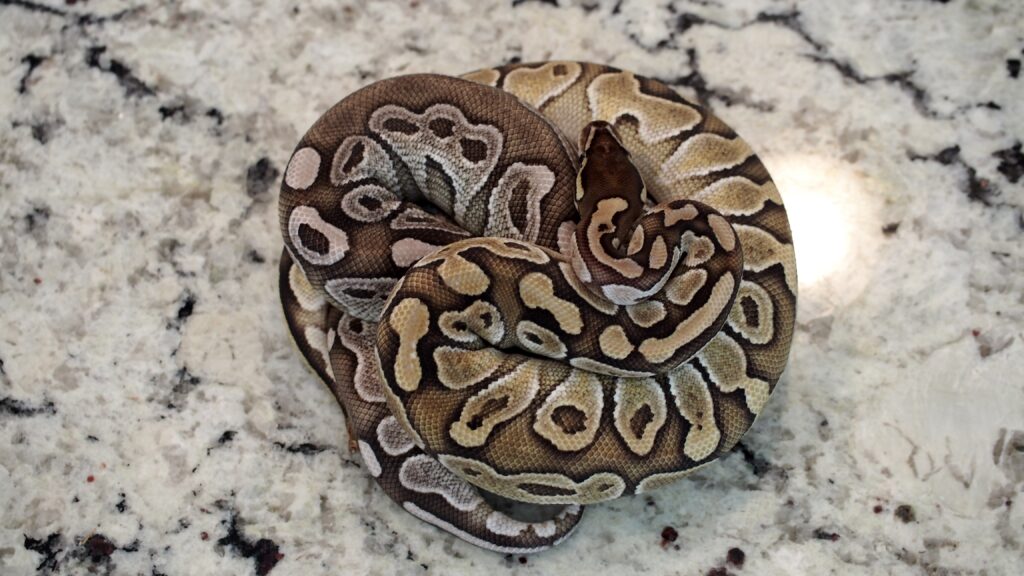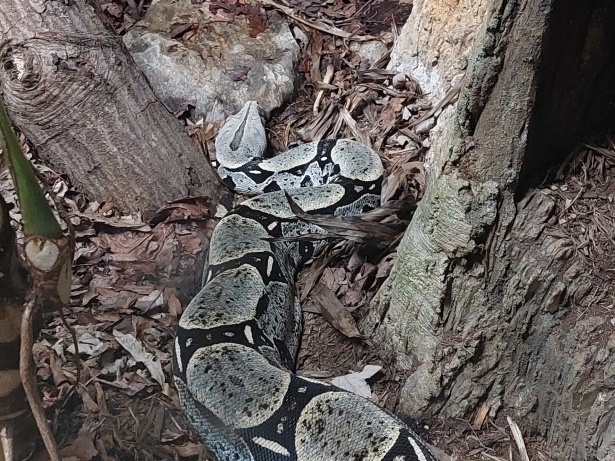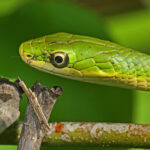You’re fascinated by the beauty and mystery of axanthic ball pythons. These rare creatures are highly coveted by reptile enthusiasts due to their unique color mutation, which reduces the yellow pigment-producing cells in their skin. The result is a striking black and white pattern that is both beautiful and intriguing.
But what do we really know about axanthic ball python genetics? How did this mutation come about, and what are the different bloodlines that make up this fascinating species?
In this article, we’ll delve into the world of axanthic ball pythons, exploring the intricate genetics behind their unique coloration and the challenges of breeding pure specimens. Get ready to uncover the mysteries of this mesmerizing reptile and gain a deeper understanding of the world of color morphs and genetics.
Table of Contents
Key Takeaways
- Axanthic Ball Pythons are a rare color morph of the Ball Python, resulting from a recessive color mutation that reduces yellow pigment-producing cells.
- They were first bred in 1997 and are most commonly descended from VPI, Snake Keeper, Jolliff, and Markus Jayne bloodlines.
- Breeding pure Axanthic pythons is difficult, and different bloodlines can be incompatible with each other.
- Axanthic pythons can be bred with other morphs to create unique combinations, and specialized morphs include Axanthic Pied, Pastel, Black, Red, Spider, Clown, and Bumblebee, with the Super Pastel Axanthic and Stormtrooper morphs being particularly famous.
Axanthic Ball Python: Color Morphs and Genetics

You’ll be fascinated to learn how the recessive genetics of axanthic ball pythons produce unique color morphs. While axanthism is a recessive genetic mutation that reduces yellow pigment-producing cells, it can be combined with other dominant genes to create new and exciting color variations.
Some of these specialized morphs include Axanthic Pied, Pastel, Black, Red, Spider, Clown, and Bumblebee. The inheritance of these morphs is complex and still not fully understood, but it’s clear that they can add significant value to breeding programs.
Through selective breeding and genetic testing, breeders can manipulate morphs and create new combinations. It’s also important to note that some morphs can be confused with axanthic ball pythons, so it’s crucial to have a thorough understanding of the genetics involved before making breeding decisions.
Breeding and Bloodlines of Axanthic Ball Python
Pairing the proper bloodlines is pivotal in producing the perfect progeny when breeding Axanthic Ball Pythons. The VPI bloodline is the most desirable due to its unique silver and gray coloration throughout the snake’s life.
However, other bloodlines such as Jolliff retain unique patterns better than other breeds. It is important to note that different bloodlines are incompatible with each other, and breeding two incompatible bloodlines can result in offspring with undesirable traits.
Breeding pure Axanthic pythons is difficult due to the recessive nature of the Axanthic gene. Homozygous breeding results in a 100% clutch of Axanthic Pythons, while heterozygous breeding results in a 50% chance of Axanthic offspring.
Breeding two heterozygous snakes gives a 25% chance of Axanthic offspring. However, incompatibility issues between bloodlines and breeding challenges make it important to carefully select breeding pairs to produce healthy and genetically diverse offspring.
Popularity and Future Discoveries
If you’re interested in the world of reptiles, you may have noticed that Axanthic Ball Pythons are becoming increasingly popular among breeders and collectors alike.
As more people become fascinated with these rare color morphs, there is a growing interest in uncovering the mysteries of their genetics. Research in this area is ongoing and may contribute to a better understanding of how genes interact to produce unique traits.
In addition to genetics research, conservation efforts are also important for the future of Axanthic Ball Pythons. As demand for these snakes increases, it’s crucial to ensure that breeding practices are ethical and sustainable.
Some organizations are working to protect the wild populations of Ball Pythons from habitat loss and hunting. By supporting these efforts, we can help ensure that future generations can continue to enjoy the beauty and wonder of these fascinating creatures.
Frequently Asked Questions
What is the natural habitat of the Axanthic Ball Python?
You may be curious about where Axanthic Ball Pythons thrive in the wild. These snakes are native to West and Central Africa, with a natural habitat that includes grasslands, savannas, and forests. Their distribution range spans from Senegal to Uganda.
Can Axanthic Ball Pythons be bred with non-Ball Python species?
Axanthic Ball Pythons cannot be bred with non-ball python species due to breeding limitations. Hybridization possibilities are limited to other ball python morphs, as pure Axanthic breeding is difficult and different bloodlines are incompatible with each other.
Are there any health concerns specific to Axanthic Ball Pythons?
When it comes to health concerns for Axanthic Ball Pythons, breeding risks are the main issue. Inbreeding can lead to genetic abnormalities and weakened immune systems. However, color variation itself does not pose any specific health concerns.
How long do Axanthic Ball Pythons typically live in captivity?
Axanthic Ball Pythons have a lifespan of 20-30 years in captivity with proper care requirements. These include providing a suitable enclosure, proper temperature and humidity, a balanced diet, and regular health check-ups to ensure their well-being.
What is the process for determining the exact genetic makeup of an Axanthic Ball Python?
To determine the exact genetic makeup of an Axanthic Ball Python, genetic testing can be performed using DNA sequencing. This process can reveal the presence of the recessive Axanthic gene and other morphs or mutations present in the snake’s DNA.
Conclusion
Congratulations on delving into the fascinating world of Axanthic Ball Python genetics! You now understand the complex nature of breeding and the various bloodlines that contribute to the unique characteristics of these snakes.
With the rarity and high demand for Axanthic Ball Pythons, it’s no wonder that they are highly coveted by reptile enthusiasts worldwide. One interesting anecdote to consider is the analogy of Axanthic Ball Pythons to a rare piece of art. Just as a rare painting or sculpture can fetch a high price due to its uniqueness and beauty, Axanthic Ball Pythons are prized for their rare color and genetic makeup.
As with any work of art, the value of Axanthic Ball Pythons only increases with time and rarity. As more research is conducted on the genetics of Axanthic Ball Pythons, it is likely that more mysteries will be uncovered. Perhaps new bloodlines will be discovered, or even new mutations that could lead to even more unique color morphs.
One thing is for certain – the world of Axanthic Ball Python genetics is a never-ending source of fascination and intrigue.


